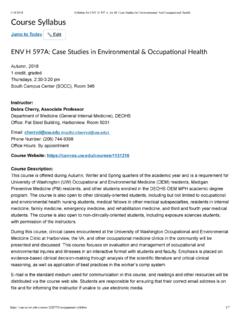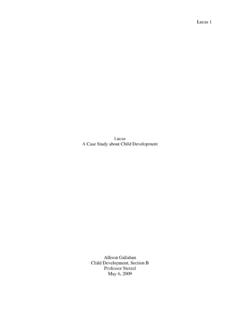Transcription of Recommended Readings for Public History Courses Case …
1 Recommended Readings for Public History Courses case studies Prepared by the NCPH Curriculum and Training Committee, July 2011 Baron, Christine. One if by Land! Two if by River! Or, What if Everything You Thought You Knew were Wrong? The History Teacher 43 (August 2010): 607-615. This article gives a brief account of the difficulties encountered when historians and educators attempted to reinterpret the Old North Church, Boston. It addresses the difficulties of catering to a diverse Public at a well-known, but largely unexplored site, and a generally misunderstood core story. The first half of the article lays out all the problems discovered when the reinterpretation efforts began, while the second half outlines how those problems were addressed by combining learning theory and unique technological solutions.
2 Written in a jaunty prose, this article is a great introduction to the headaches you ll suffer, and good humor needed, when working with historic sites. Blight, David W. Race and Reunion: The Civil War in American Memory. Cambridge: The Belknap Press of Harvard University Press, 2001. Blight s book particularly Chapter 10, "Fifty Years of Freedom and Reunion," offers African American perspectives on the Civil War. Paired with Scott Casper s case -study (see below), this book , is particularly relevant during the current Civil War sesquicentennial. It enables students to tangle with popular memory, professional manipulation, and the big business of historic site interpretation, Bruggeman, Seth. Here George Washington Was Born: Memory, Material Culture and the Public History of a National Monument.
3 Athens: University of Georgia, 2008. Bruggeman examines the broader History of commemoration in the United States by focusing on the George Washington Birthplace National Monument, where contests of Public memory have unfolded with particular vigor for nearly eighty years. He raises a number of questions about restoration, material culture and memory. Casper, Scott E. Sarah Johnson's Mount Vernon: The Forgotten History of an American Shrine. New York: Hill and Wang, 2008. Casper focuses on the black caretakers of Mount Vernon, a decision that adds race as an additional perspective to gender when analyzing constructions of memory and interpretation of at historic places. Students respond enthusiastically to Casper's study of Mount Vernon for many reasons. Many students know the site well and can envision elements of Casper s study clearly, but even students who do not know Mount Vernon found the story of forgotten people powerful.
4 They all appreciated the historic perspective on debates about visitor services, food on site, and destruction of historic property by visitors seeking a piece of the true cross. The realization that personality clashes had happened at historic sites in the past, provided an interesting perspective during later discussions on managing conflict. Ywone, Edwards-Ingram. Toward True Acts Of Inclusion: The Here and the Out There Concepts in Public Archaeology. Historical Archaeology 31 (1997): 27-35. Historical archaeologists deal with a number of the same issues that are central to Public History . This article provides an opportunity to talk about multi-disciplinary approaches to the past and to focus on the need to reconcile scholarship with Public interest.
5 It might be useful to pair it with Erica Martin Seibert. African-American Archaeological Sites & the National Register of Historic Places: Creating a Public Memory. African-American Archaeology: Newsletter of the African-American Archaeology Network. 2000, page 27. Fink, Leon. "When Community Comes Home to Roost: The Southern Milltown as Lost Cause." The Journal of Social History 40 (Fall 2006): 119-145. This is a really smart piece about the politics of doing Public and oral History , which looks at the various stances and interests among different types of people doing History in Public (in this case , a pair of local activists and community organizers who were doing Public History type projects, and the author himself, an outsider and professional who was initially welcomed and then rejected by the activists when they realized he was going to include them in his study).
6 It's a good piece for getting students talking about the politics of knowledge-making and the layers of insider/outsider politics in any community, as well as getting them to question the too-easy assumption of "community" as an entity or an unproblematic good. Handler, Richard and Eric Gable. The New History in an Old Museum: Creating the Past at Colonial Williamsburg. Durham: Duke U. Press, 1997. The case study, conducted by anthropologists Handle and Gable, raises pertinent questions about the value of first person interpretation, the weight of an institution s own past, and relationships among historians and other on-site personnel. The research and resulting publications leading up to and including this book generated heated debate and discussion. It is useful to pair a reading of the book or selected chapters with Cary Carson, "Colonial Williamsburg and the Practice of Interpretive Planning in American History Museums," The Public Historian 20:3 (summer 1998), 11 51 Linenthal, Edward T.
7 Preserving Memory: The Struggle to Create America s Holocaust Museum. New York: Columbia University Press, 2001. Linenthal s detailed examination of the decision making process leading up to the creation of the United States Holocaust Memorial Museum provides a powerful case study for discussing issues related to authority and museums in Public History interpretation. Loewen, James. Lies Across America: What Our Historic Sites Get Wrong. New York: Touchstone, 2000. The five opening essays in Loewen s book offer a general introduction to some challenges facing Public History and Public History education. I have used the essays on the first day of my introductory course. I have also used them in some of my other History Courses . In addition, the book includes about 95 short essays that treat individual sites.
8 When I have worked with Hampdon National Historic Site in Baltimore, I have used Loewen s essay to spark conversation and encourage new interpretation. Lowen s work also raises important questions about the nature of truth in Public History and particularly whether or not omitting information --or offering an interpretation that is different from the one he would like to see presented really constitutes lying. For this reason, it might be interesting to pair selections from Lies Across America with selections from Kenneth Foote Shadowed Ground: America s Landscapes of Violence and Tragedy (University of Texas, Updated Version, 2003) which asks us to consider the sites Americans have chosen to destroy or ignore. Mazrim, Robert. The Sangamo Frontier: History and Archaeology in the Shadow of Lincoln.
9 Chicago: University of Chicago Press, 2007. Mazrim s study recounts the ways in which a professional architect and the CCC expanded Lincoln s New Salem, one of the open air museums in the United States. Of particular interest are pages 275-319. You can supplement the book with more information on architect Joseph F. Booton and his work at New Salem and beyond with an article by Barbara Burlison Mooney, "Lincoln's New Salem: Or, the Trigonometric Theorem of Vernacular Restoration." Perspectives in Vernacular Architecture 11 (2004): 19-39. Moyer, Theresa and Paul Shackel. A Devil, Two Rivers and a Dream: The Making of Harper's Ferry National Historical Park. Lanham, Md.: Alta Mira Press, 2007. This book can be divided into two classroom discussions. The first portion of the book lends itself well to a discussion about the complicated History of historic places.
10 Even the most sophisticated students often have not given much thought to the construction of place, and this book provides a window into the cultural geography of Harper's Ferry. The second portion of the book frames a discussion about the ways in which interpretation evolves over time. The book demonstrates the ways in which specific social and cultural conditions can make the concerns of some stakeholders appear more valid than others. It's a good touchstone throughout the semester for talking about reflexive learning, collaborative inquiry and collaborative interpretation. Pitcaithley, Dwight. Abraham Lincoln s Birthplace Cabin: The Making of an American Icon in Myth, Memory, and the Making of the American Landscape. Paul A. Shackel, ed. Gainesville: University Press of Florida, 2001.









